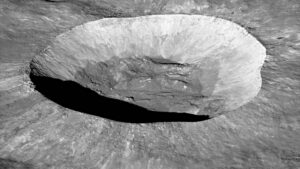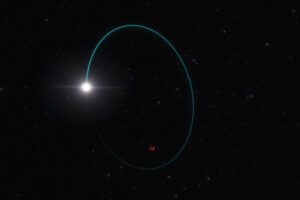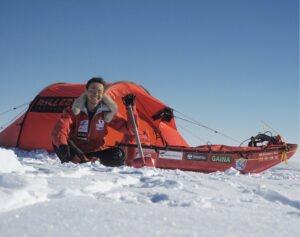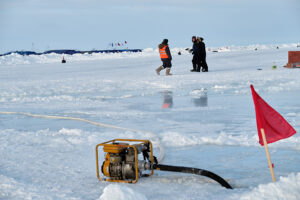Ice River and science mission: Ramón Larramendi and team traveled with wind and solar power.
Spaniard, Ramón Larramendi is the designer and builder of the 2-ton Windsled. He led the team, Hilo Moreno (ES), Nacho García (ES), Jens Jacob Simonsen (Greenlandic) and Ross Edwards (Australian-American), from the ice near Kangerlussuaq to the Science Station, EastGRIP. A distance of more than 1000 km, 621 miles. Their main aim was to reach the Ice River and to present a low-carbon platform for science research, to collected shallow ice cores along the way.
Getting on the ice
At Kangerlussuaq, where the team started to assemble the Windsled, they also had to deal with other “tensions”. The airline lost some of their luggage, “precisely the one in which the GPR (ground penetrating radar) was prepared by the glaciologist Francisco Navarro and his team.” Fortunately it ended showing up on time, they reported. “And secondly, US security measures have increased, and we were required by the nearby military base additional paperwork to begin the expedition.”
Eventually, after a weather delay, on May 23 a helicopter dropped them on the ice near Kangerlussuaq, 1,500 meters (4921 ft) above sea level. Once on the ice, they assembled the Windsled and the tents it carries. Apart from solar panels and batteries, which had to be well secured as they can travel at high speeds, “the most complicated issue will be the fine tuning of all scientific devices on board (air manifold, mobile weather station, GPR…),” reported the team. It took them two days of “intense work” to assemble the sled.
Forward
They began with a strong southeast wind, “the best by our standards, and we progressed with a 30-square-meter (323 sq ft) kite dragging our 2,000 kilos (4,400 lbs) of weight uphill, to almost 2,000 meters (6,561 ft) of altitude. We reached 13 km (8 mi) / hour, too fast…Then we changed to the 60 square meter (646 sq ft) one, very hard to handle, until the wind lessened, and finally we returned to the 80 sq m (861 sq ft) kite and the speed stabilized at 7 km (4.3 mi) / hour,” reported the team.
All favorable winds had to be used and therefore the men worked in two teams. Ramon and Jens Jacob formed one team, and Hilo, Ross and Nacho the other. Some had to sleep by day, which was difficult to get use to. Later on in the expedition the 5 men took turns to pilot every hour, in the 24-hour daylight.
Science
For the collection of the ice cores they dug holes of two meters (6 ft) in depth, “a task which Ross was determined to perform while the rest of the crew reposed after a hard day. Once the hole was made, our on-board investigator obtained much data on snow conditions: temperature, density, humidity…several parameters that are required by the Dark Snow project.”
Ross Edwards, a polar climatologist, conducted these drillings and was in charge of all the science details, and dressed up in a white sterilized suit and mask when doing his job. The snow samples were stored in special containers to keep them from melting.
On June 13th the team explained they arrived perfectly at the planned coordinates. “Ross’s objective is to drill exactly in the same place done two years ago on another expedition – in this case, traveling by snowmobile – in order to ascertain how the current is moving when comparing between our findings and those previous ones.”
“We have not explained it, but in each hole we drill we reach snowstorm layers that fell between 12 and 15 years ago, a period long enough to detect interesting changes. Snow and ice are like a blank sheet of paper where everything that comes by is printed every time and what happened next (thaw, freeze…) too. It is curious to observe how the differences between some strata and others are noticed, depending on the changes. And one detail: now Ross drills without us having to lower the kite, which always takes us a long time. Do not forget that it is quite far from the WindSled, sometimes 300 m (984 ft) away, and lifting it is laborious.”
In line with Ross their low-emission goal, Ross also developed a system to melt snow without using the fuel that is brought for cooking and heating. “It consists of putting snow inside some special plastics in the tent, and taking advantage of the greenhouse effect. That will allow us to save at least half the fuel we spend per expedition. In fact, we are also thinking about how we could install an electric cooker that functions with solar panels. We would then be absolutely 100% zero emissions.”
Ice River
One of the goals of the expedition was to reach the highest area and the dividing line of the slope with the Greenland great mass of inner ice, the Ice River. On June 10, Ramon and Hilo navigated them to the waypoint the scientists gave them, the exact coordinate of the divide between one slope and another of the inner Greenland glacier. This is where the ‘Ice River’ begins, which empties into the oceans of ice, explained the team.
EastGRIP
On June 20, 2017, the 5 men reached the Science Station, EastGRIP. Latitude 75.63, Longitude -36.00, Altitude 2660 m (8727 ft). 36 scientists from 12 countries, who are spending the summer there, are developing their projects, especially the Greenland Ice Core Drilling Project. The Windsled team also wrote about visiting the site of the 2500 m (8202 ft) in depth perforation to reach the base of the Greenland rock. They are currently at 450 m (1476 ft).
Ramon and the team dismantled the sled and flew back to Kangerlussuaq.
Links
Expedition diary (English)
Expedition diary (Spanish)
Hilo Moreno’s profile on Pythom
Follow the team diaries in the Dispatch Stream on pythom.com
Previous on Explorersweb/Pythom
2016: Greenland Windsled update
2016 Windsled completed mission across Greenland
2012: Antarctica windsled crossing completed
2005: Spaniards reach South Pole of Inaccessibility – but where is Lenin?
2005: Spaniards reach the ‘second’ South Pole of Inaccessibility – still no trace of Lenin
Heads-up from Spanish team with special challenges 220km to the South Pole
Iceland trekking and packraft crossing: Hilo Moreno talks to Exweb (2015)
Debrief: Hilo Moreno and Daniel Lambert 1300 km Yukon paddle (2012)
Debrief: José Mijares and Hilo Morenos Svalbard expedition (2010)
#polar #Greenland #RamónLarramendi #windsled #IceRiverGreenland






